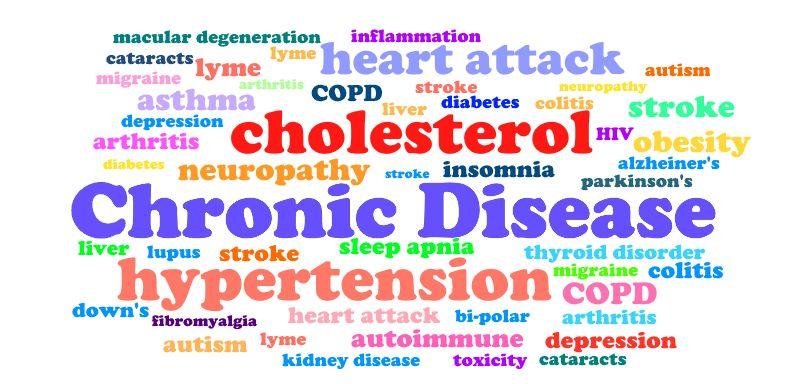
5 minute read
Chronic illnesses (J Cordill, M Fernandez, W Sun

Introduction The US National Center for Health Statistics defines a chronic illness as a disease or illness that persists for longer than three months. In 2016, the United States spent 1.1 trillion dollars on treatment for chronic health conditions. The Center for Disease Control and Prevention reported that over 1.7 million Americans died from chronic illnesses in 2018. This poster will highlight three chronic illnesses: Alzheimer’s, porphyria, and fatal insomnia syndrome. These three chronic illnesses currently do not have any cures. https://www.purdue.edu/newsroom/purduetoday/ didyouknow/2016/Q1/did-you-know-purdue-seal. html
Advertisement
Different Chronic Ilnesses https://www.lcdhd.org/info-tools/ health-assessments-and-statisti cs/health_report_card/chronic-ill ness/
Alzheimer’s ● Disease that progressively destroys memories and other important mental functions, such as communication, behavior and awareness. ● Brought on by the atrophy of cortical and subcortical structures , such as the hippocampus, which is important for memory formation. This destruction is brought on by accumulation of amyloid plaques and inflammation in the brain leading to neuron death. This cell death causes the brain to undergo degradation and shrink, as shown on Figure 1. ● There is no cure, but cholinesterase inhibitors aid with keeping memory, while doll therapies, which involve giving dolls to patients, which can aid in dealing with distress by bringing back happy early parenthood memories. Dog therapies also aid in treating agitation and stress associated with Alzheimer’s by allowing the patients to interact with more people ● Data indicates higher incidence of Alzheimer’s in developing nations, specifically in sub-Saharan Africa and Latin American countries. This is likely due to decreased education, which is a large environmental risk factor for Alzheimer’s and dementia. ● In the United States alone, five million people have Alzheimer’s, with 83,000 people dying as a result every year. Alzheimer’s also costs the US $277 billion dollars a year in healthcare costs alone



Opinion: As Americans continue to live longer, Alzheimer’s will continue to become an even larger health crisis. By 2050, the number of cases of Alzheimer’s in the United States will more than quadruple in number. To combat this, there are several actions that must be taken. For one, increased funding in research by the government can aid in providing both a greater understanding in the pathology and epidemiology of Alzheimer's and by providing more financial resources for developing therapeutic interventions. Second, education must be expanded so that everyone can have access to it easily. Research indicates that the more education a person receives, the less likely they are to get Alzheimer’s due to an increase in neuronal density. Making all education, including college, freely available would aid in combating the Alzheimer’s epidemic (M. Fernandez) Porphyria: ● Disorder that results from a buildup of chemicals that produce porphyrin ● Porphyria cutanea tarda is the most common type of porphyria and symptoms include red/brown urine (Figure 2), skin rashes, muscle cramps, and severe abdominal pain ● The acute forms of this disease occur when porphyrins build up in and damage the nervous system ● Occurs more frequently in northern European countries such as Sweden and the United Kingdom due to autosomal dominant inheritance of gene mutations. ● Each form of porphyria results from mutations in either the ALAD, ALAS2, CPOX, or UROD genes. These genes provide instructions for making the enzymes needed to produce heme. Mutations in any of these genes reduce enzyme activity, which limits the amount of heme the body can produce. Porphyrins, which are formed during the process of heme production, can build up abnormally in the liver and other organs ● Givosiran, a new RNAi therapeutic developed by Alnylam Pharmaceuticals for the treatment of acute hepatic porphyria, was granted priority review by the FDA in August 2019 Opinion: Porphyria is a global issue that isn’t getting enough attention. It is estimated that between 1-5 million people suffer from this chronic illness each year. Although it’s largely inherited genetically, a healthy lifestyle has been shown to help patients living with porphyria. According to the American Porphyria Foundation, factors such as physical/mental stress, alcohol, smoking, and fasting can trigger symptoms of porphyria, which is why it is important to spread awareness to patients and their families (J. Cordill). Figure 2: Porphyria Urine https://en.wikipedia.org/wiki/Porphyria #/media/File:Urine_of_patient_with_po rphyria.png Figure 1: Alzheimer’s brain comparison: https://www.nia.nih.gov/health/alzheim ers-disease-fact-sheet
Fatal Insomnia:
● Genetic prion disease that causes neuron loss in the thalamus ● Symptoms include trouble falling and staying asleep (Figure 3), lack of appetite, progressive dementia, loss of coordination and memory, hallucinations, delirium, coma and death within 12-18 months of symptoms ● Inherited genetic mutation of PRNP gene (autosomal dominant),the PRNP gene provides instructions for making a protein called prion protein (PrP), which is active in the brain and several other tissues. ● The PrP has no precise functions known, but it is shown by studies from researchers that this protein can be used for neuroprotection as well as neural cell-cell communications. ● Currently no effective treatment but clinical trials are ongoing. Several forms of immunotherapy have reported success
Opinion: I think more testing could be done to find a cure for this disease and more funding for research to find a cure. I think there are ways to alleviate the symptoms such as taking different vitamin B supplements for a few days at a time. Another method to alleviate symptoms is to take melatonin during the mild stages (W.Sun).
References: Fatal familial insomnia. Genetic and Rare Diseases Information Center. https://rarediseases.info.nih.gov/diseases/6429/fatal-familial-insomnia. Accessed March 26, 2020. PRNP gene - Genetics Home Reference - NIH. U.S. National Library of Medicine. https://ghr.nlm.nih.gov/gene/PRNP#conditions. Accessed March 26, 2020. Schenkein J, Montagna P. Self-management of fatal familial insomnia. Part 2: case report. MedGenMed : Medscape general medicine. https://www.ncbi.nlm.nih.gov/pmc/articles/PMC1781276/. Published September 14, 2006. Accessed March 26, 2020. Bernell S, Howard SW. Use Your Words Carefully: What Is a Chronic Disease? Frontiers in Public Health. 2016;4. doi:10.3389/fpubh.2016.00159. Chronic Diseases in America. Centers for Disease Control and Prevention. https://www.cdc.gov/chronicdisease/resources/infographic/chronic-diseases.htm. Published October 23, 2019. Accessed March 26, 2020. Facts and Figures. Alzheimer's Disease and Dementia. https://www.alz.org/alzheimers-dementia/facts-figures. Accessed March 26, 2020. Gorelick PB. Alzheimer's disease and vascular dementia in developing countries: prevalence, management, and risk factors. Lancet Neurology. 2004;35(11_suppl_1):2620-2622. doi:10.1161/01.str.0000143318.70292.47. How Is Alzheimer's Disease Treated? National Institute on Aging. https://www.nia.nih.gov/health/how-alzheimers-disease-treated. Accessed March 26, 2020. Mortimer JA, Graves AB. Education and other socioeconomic determinants of dementia and Alzheimer's disease . Journal of the American Medical Association. doi:10.36959/734. Porphyria. U.S. National Library of Medicine. https://ghr.nlm.nih.gov/condition/porphyria#. Published July 2009. Accessed March 2020. FDA approves first treatment for inherited rare disease . U.S. Food and Drug Administration . https://www.fda.gov/news-events/press-announcements/fda-approves-first-treatment-inherited-rare-disease. Published November 2019. Accessed March 2020. Melao A. Certain Dietary, Lifestyle Factors Linked to Lower AIP Disease Activity, Study Suggests. Porphyria News. https://porphyrianews.com/2019/01/11/dietary-patterns-linked-to-acute-intermittent-porphyria-activity/. Published January 2019. Accessed March 2020.











